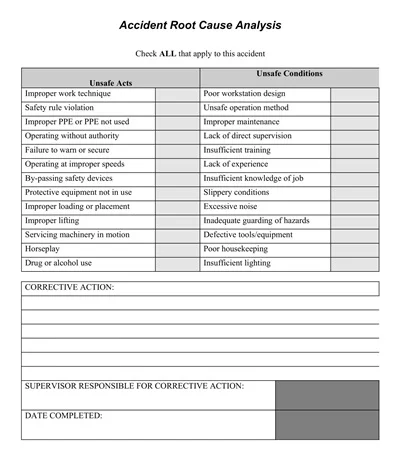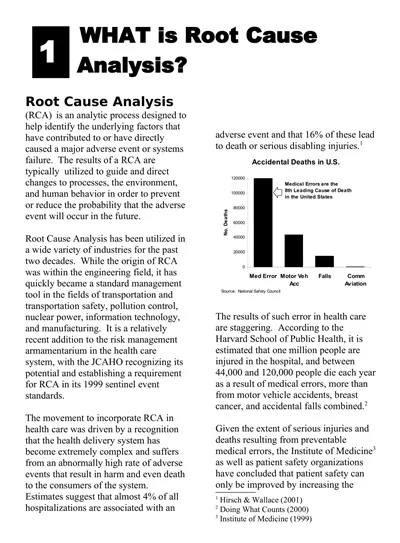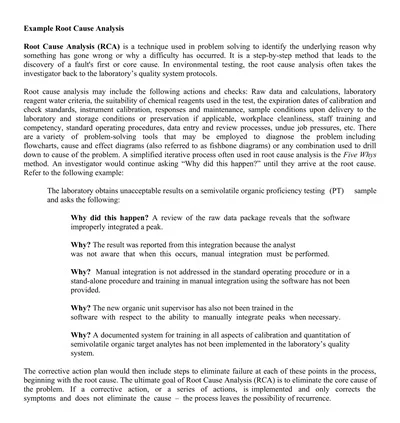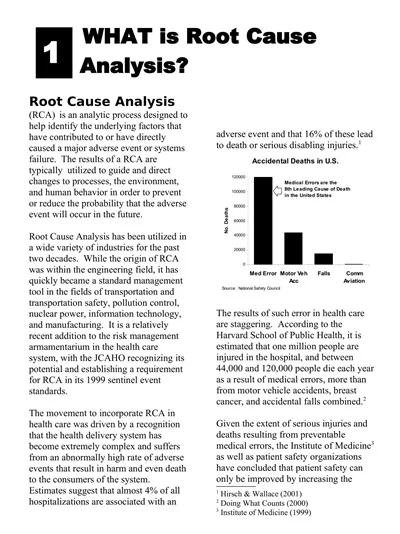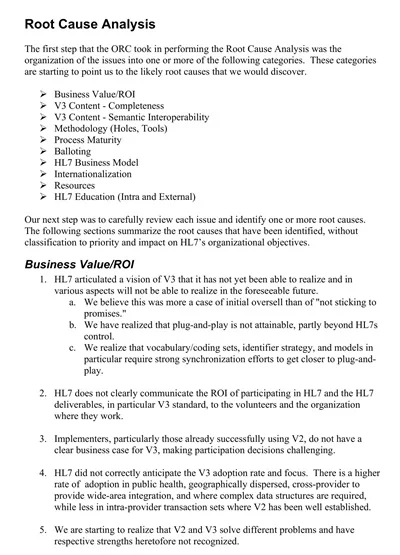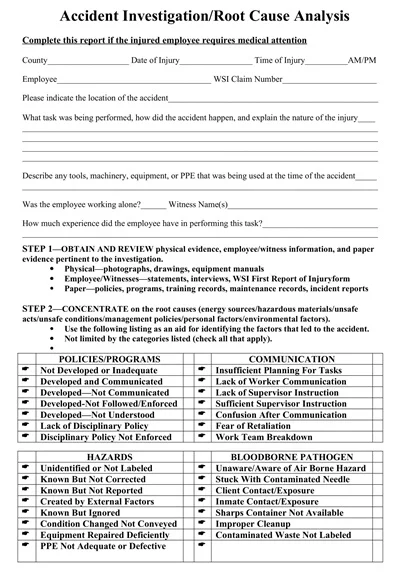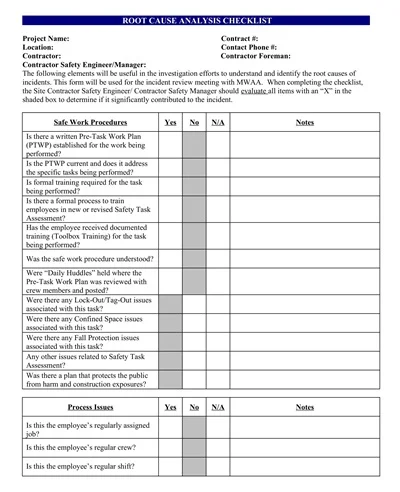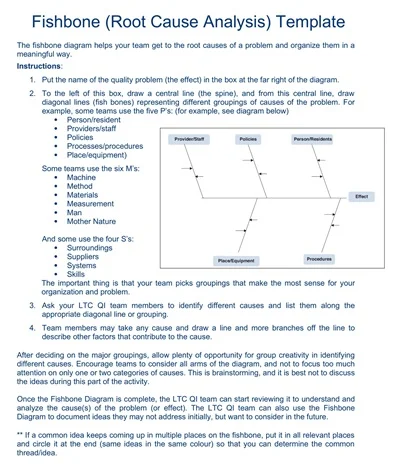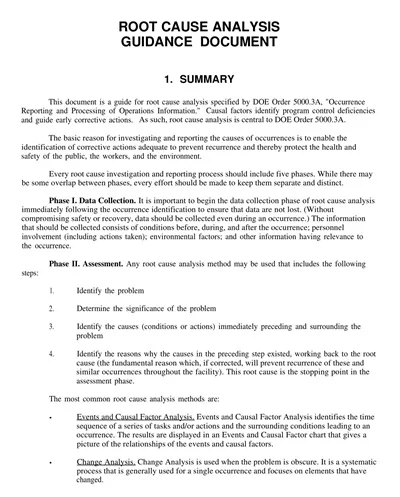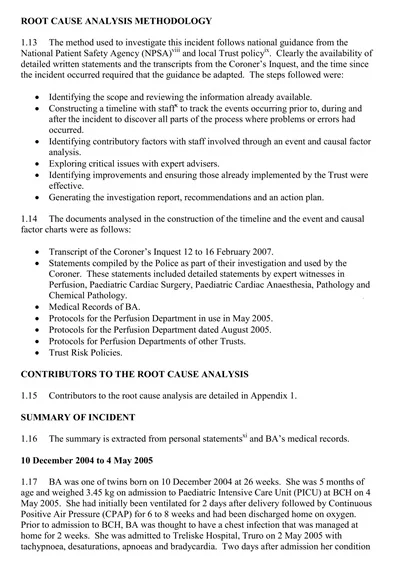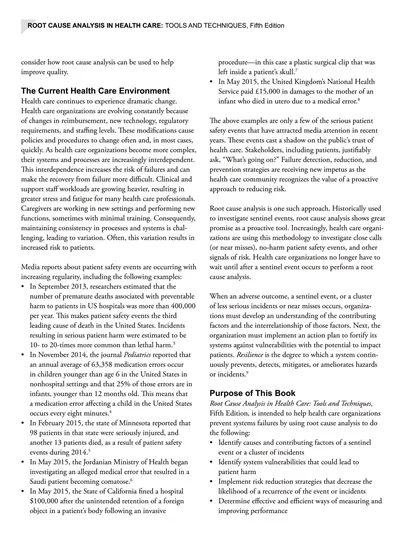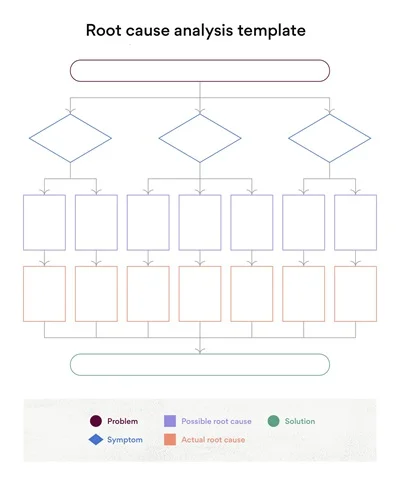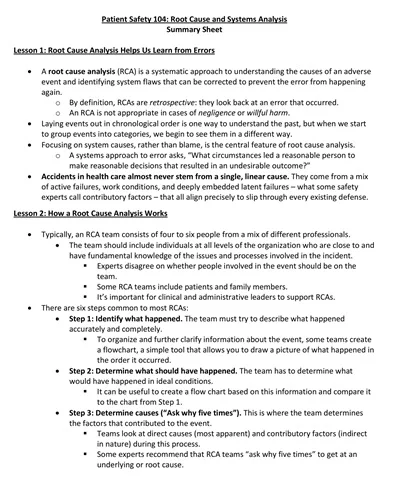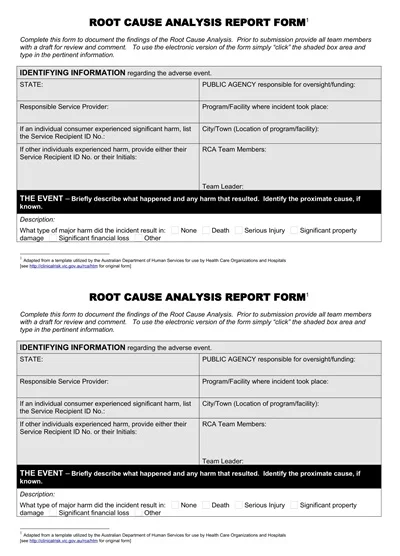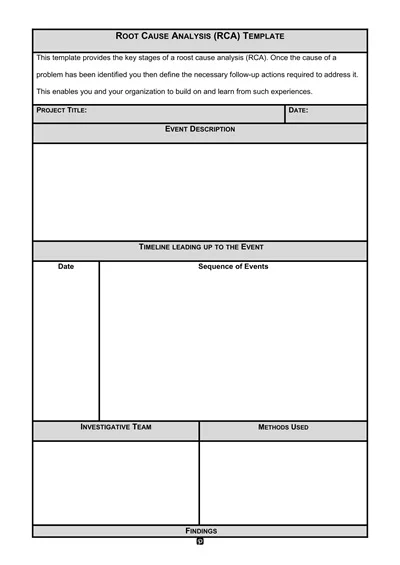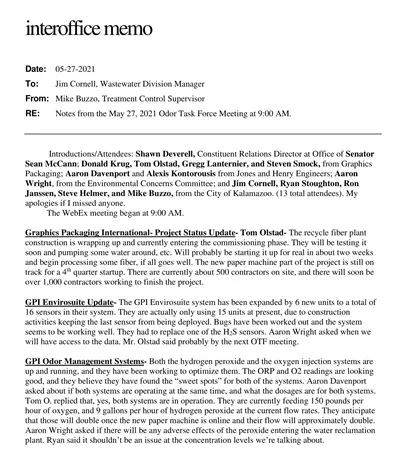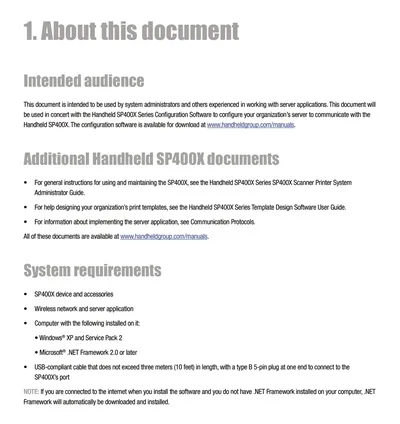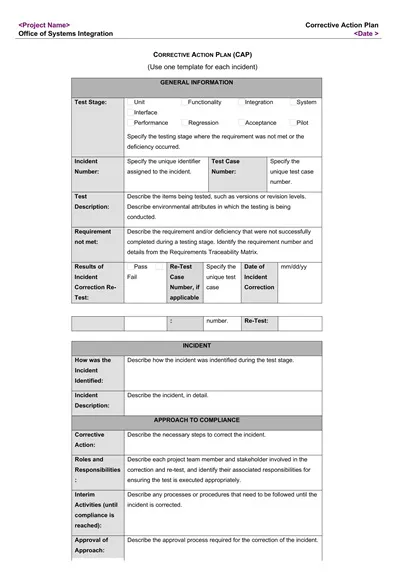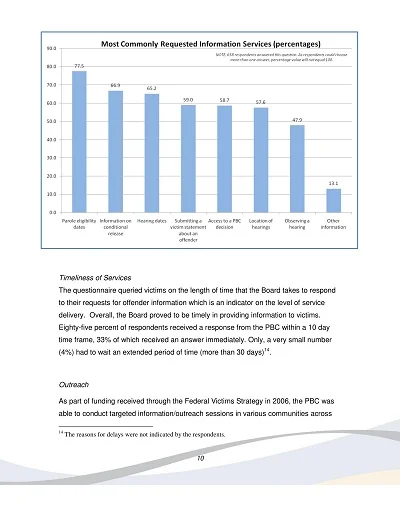Root Cause Analysis template is another tool that is formatted and can have many levels of analysis for finding the basic reasons for the events or circumstances of importance. The rationale behind selecting an RCA template is to construct a sound reason for the investigation and analysis of the problem and formulate a solution.
The general framework is common in problem determination, data acquisition, identification of potential causes of the problem, definition of overall cause, and introduction of potential solutions. This procedure also enables users to build a stronger shield against such arising issues and challenges that come with it, not even to mention the future ones.
Download Free Root Cause Analysis Templates
What is a Root Cause Analysis?
Root Cause Analysis (RCA) is a systematic approach used to assess factors that are hidden beneath the observable cause levels of an occurring problem or event. This way, organizations can demonstrate where the issues are arising from and are in a position to strategize how to appropriately address the whole gamut of strategies to ensure the tragedy does not happen again.
RCA is all about data collection, mapping the route of events, and analysis of how they help get into the root problem’s causation rather than using the treatment as the route map to the use of the symptoms. On a broader scale, such an approach is also used by various industries like the health care industry, engineering, and business, where the knowledge of the root cause could help affect changes in the process, eliminate or reduce risks, and lower costs.
What’s Included in a Root Cause Analysis
Despite being translated as “Root Cause Analysis,” its main purpose is to help identify the root causes of a problem. This way, an organization is better positioned to address the basic problem that leads to the development of symptoms, not just cure the symptoms.
Typical elements included in an RCA are:
- Problem Statement: Remember to make your stand as elaborate as possible and ensure that you include highlights of the issue, consequence, or size.
- Data Collection: Collect all the possible data regarding the processes and applications under consideration, as well as the logs and reports of the affected parties.
- Cause Identification: Use procedures such as the 5 Why Method or Fishbone Chart to identify probable causes.
- Root Cause Verification: To support the matter a reference should be made back to the identified point of origin of the issue in order to substantiate based on corroboration.
- Corrective Actions: It is necessary to develop and implement measures to eliminate the problem’s source and introduce safety measures so that the problem does not repeat itself.
- Effectiveness Measurement: Summarize the actions taken to solve the problem to ensure that it is as Hoy (2014) mentioned to find out that everything worked out.
- Documentation: Place all those findings, analyses, and actions in your record book, thus waiting for the day it will get attention from you and other staff.
Such steps address the questions of the structured approach bases, which create the approach towards solving a complex issue without achieving a non-achievement.
Principles of Root Cause Analysis
Root cause analysis aims to reveal the reasons behind the problems or issues that went wrong in any given situation. Initially however, this analysis seeks to establish the following: The main aim of conducting an analysis is what happened, why it happened, and how to understand what has happened not to happen again. Thus, the RCA principles facilitate achieving a good analysis that will be thorough, clear, and well-organized.
1. Problem Definition
The first approach is to examine the problem from the perspectives of systems analysis and root-and-branch methodology. Here, I am about to describe the problem and attempt to state the problem/symptoms that I have observed.
2. Cue Accumulation and Evidence Assemblage
The most crucial phase when approaching a problem is the assessment phase through collecting data and information. It is evident in records/Interviews; observation; and physical evidence.
3. Identifying Possible Causes
Last, I would collect that data and pinpoint all related and conceivable causes. This is often done with meetings that handle activities like idea generation and the use of tools, including the plan-do-check-act and cause-and-effect diagrams.
4. Analyzing Causes
Consider the amount of impact and the relevance of the cause you have chosen for yourself. This recognizes the fact that there are diverse approaches to outlining the main cause since one cause cannot be enough to address complex issues.
5. Identifying the Root Cause(s)
Based on the analysis findings above, highlight the root cause or causes of the problem below. As much as it is essential to determine what led to the matter being an issue in the first place, it is also crucial to identify the fundamental issue that would offer or deny repetition of the matter.
6. Developing Corrective Actions
Synchronize the program-related activities to address the root causes of the issues. These should meet the specifics of specific, measurable, achievable, relevant, and time-bound (SMART).
7. Implementing Corrective Actions
Place the correction treatments into either the treatment time frame that has been previously planned or into the tolerable time frame. This should include distributing roles and making sure proper resources are available.
8. Monitoring Effectiveness
Always monitor and assess the returns of the changes you have implemented in your strategy. This step will prove that the problem has been solved, and the repeat of the same problem will be minimized.
9. Documenting the Process
Do them properly and document the RCA investigation process systematically. The documentation leaves behind an internal knowledge package that can be used in case one intends to reuse research analysis done in the past to enhance the organization’s learning process.
Benefits of using the Root Cause Analysis
RCA’s benefits include the following: The main benefit of Root Cause Analysis or RCA is that it results in numerous advantages, particularly when it comes to enhancing processes on different aspects of quality control to make work better in numerous sectors of the economy.
RCA, therefore, brings a difference in the identification of the cause of the problems, allowing for change in processes that would otherwise lead to repetition of the problems, hence time, resource, and cost savings. It would also allow organizations to identify and manage the treatment of the symptoms and be in a position to perform corrective actions to allow the organizations to tackle the upstream issues.
RCA also makes a contribution through raising people’s awareness of the complicated machines and processes in order to become a standard that foster a culture for performing improvement continuously and defines proactive measures to problems. Consequently, the companies involved realize greater and tangible savings, the customer retention rate is greatly boosted, and the competitive advantage is enhanced.
Advantages and Disadvantages of Root Cause Analysis
Root Cause Analysis (RCA) is an all-inclusive tool intended to identify the fundamental causes of problems or occurrences and address the possibility of recurring.
Here are some of the advantages and disadvantages of implementing RCA:
Advantages
- Prevention of Recurring Issues: As the name suggests, this approach seeks to ascertain the cause of a given issue because RCA aims to eradicate this, preventing the occurrence of emergent issues and aiding in the integration of permanent fixes.
- Improved Processes: RCA can expose the weaknesses in procedures and thereby enhance the acknowledgment of these organizations and efforts to enhance the efficiency of operations and processes.
- Cost Savings: In this way, organizations can effectively exclude themselves from the common set of issues, say, downtimes, defects, and the like, and thus, reduces the chances of frequent happenings of costly occurrences.
- Enhanced Safety: Special attention should be paid to identifying safety problems and the subsequent root cause in many industries, particularly in the healthcare and manufacturing sectors, because safety improvements through identifying standards may help create a better working environment by coming up with new standardized procedures.
- Informed Decision-Making: RCA gives information that can be leveraged to achieve even improved results, to make more informed decisions hence.
Disadvantages
- Time-consuming: Although conducting an RCA involves intensive efforts and massive resources, most SCDs cannot afford such efforts because the RCA process is time-consuming.
- Complexity: Therefore, RCA may be exhaustive sometimes, particularly if you are dealing with a compound issue since it may encompass several aspects. Therefore, a situation may arise when defining a single cause, which may be very difficult.
- Requires Expertise: The exercising of effective RCA at times may necessitate prowess, which, in arranging, may necessitate the hiring of outsourced experts or personnel, a process that may be highly outlawed.
- Potential Bias: The managers’ bias jeopardizes the identification of opportunities and may cause generalizations of vital patterns in nature.
- Resistance to Change: It will be critical to consider the contents of a change management system because some factors, such as resistance from the staff and the stakeholders, will put a lot of pressure on change.
In other words, using the root cause analysis does not mean that the other problems are hushed, but the RCA aids in tackling them and improving operations.
How to Create a Root Cause Analysis Template
A proper format for developing RCA can be quite useful in efficiently and effectively completing RCA. Here, let us proceed to the practical part to explain how to create the root cause analysis template step by step.
Step 1: Identify the constraints
First, one must clearly frame or identify the problem or issue of concern as a first step in developing the root cause analysis template. This stage establishes when and when it was done and the extent of its impact on the organization. It is from compiling such summaries of information regarding the issue at hand that the right analysis will be made later.
Step 2: Say that Indicate The Aims of RCA
The successive task is identifying what root cause analysis any given issue or system is aiming at. RCA should include the fact that we are to determine what we are looking for using the tool, and that would be to avoid the recurrence of a similar event or enhance all areas with aspects such as processes and systems.
Step 3: Gather a Cross-Functional Team
It is important to form a large group including employees from different divisions to encompass different perspectives of the business issue that is being solved. To achieve it, there may be people who are deeply involved in a certain subject, supervisors, and those who are directly involved in building this issue.
Step 4: Use a graphic visual device
As for the example of a flowchart or fishbone diagram, which can be viewed as other examples of a visual representation of identified potential root causes, such representations are also useful in teaching. It explains the matter adequately and then seeks associations among various matters that can cause this concern.
Step 5: Conduct Analysis
Solving the problem Using the key data points highlighted would also enable the cross-functional team to analyze the problem and look for possible precursors. This is achieved by feeding lower-level issues multiple times, which ignores the need to address them and respond accordingly, especially regarding power relations.
Step 6: Focusing on Root Causes
Not all mentioned WIFs can be significant or necessary for improving performance and eliminating mismeasurements. Thus, it is recommended to focus on the actions that may, without any doubt, be considered crucial and, vice versa, have potential beneficial outcomes for the situation.
Step 7: Generate Workable Solution
Furthermore, the team can develop solutions to eliminate the leading cause when the source is identified and priorities defined. Thus, they should be specific, measurable, achievable, realistic, and in a specific timeframe (SMART).
Step 8: Putting and Checking the Solutions into Practice
Once the solutions have been developed, a clear implementation has to be made so that the Discovery teams can check if the solutions are meeting the intended performance level. It is good for ensuring that the problem is solved well to avoid its repetition in the future.

